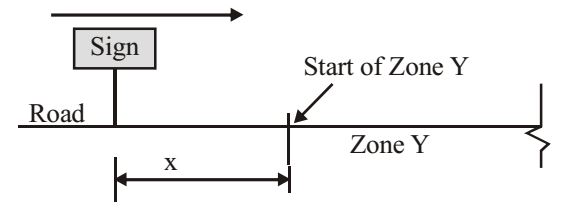Traffic engineering miscellaneous
- The minimum value of 15 minute peak hour factor on a section of a road is
-
View Hint View Answer Discuss in Forum
15 min peak hour factor,
PHF = (V / 4) V15
V - Peak hourly volume (veh/h)
V15 - Max 15 minute volume within peak hour (Veh)
Maximum value is 1.0
Minimum value is 0.25 .
Correct Option: C
15 min peak hour factor,
PHF = (V / 4) V15
V - Peak hourly volume (veh/h)
V15 - Max 15 minute volume within peak hour (Veh)
Maximum value is 1.0
Minimum value is 0.25 .
- A sign is required to be put up asking drivers to slow down to 30 km/h before entering Zone Y (see figure). On this road, vehicles require 174 m to slow down to 30 km/h( the distance of 174 m includes the distance travelled during the perception – reaction time of drivers). The sign can be read by 6/6 vision drivers from a distance of 48 m. The sign is placed at a distance of x m from the start of Zone Y so that even a 6/9 vision driver can slow down to 30 km/h before entering the zone. The minimum value of x is ________ m. Direction of vehicle movement.

-
View Hint View Answer Discuss in Forum
For a 6/6 person, driver can see from 48 m.
For a 6/9 person, driver can see from 48 × 6 = 32m 9
Vehicle requires 174m to slow to 30 kmph.
Minimum distance, x = 174 – 32 = 142mCorrect Option: C
For a 6/6 person, driver can see from 48 m.
For a 6/9 person, driver can see from 48 × 6 = 32m 9
Vehicle requires 174m to slow to 30 kmph.
Minimum distance, x = 174 – 32 = 142m
- A pre-timed four phase signal has critical lane flow rate for the first three phases as 200, 187 and 210 veh/hr with saturation flow rate of 1800 veh/hr/lane for all phases. The lost time is given as 4 seconds for each phases. If the cycle length is 60 seconds, the effective green time (in seconds) of the fourth phase is __________
-
View Hint View Answer Discuss in Forum
Lost time, L = 4 × 4 = 16 s
y1 = q1 = 200 s1 1800 y2 = q2 = 187 s2 1800 y3 = q3 = 210 s3 1800 y1 + y2 + y3 = 200 + 187 + 210 = 597 1800 1800 Co = 1.5L + 5 1 - y ⇒ 60 = (1.5 × 16) + 5 (Co = 60 s) 1 - y
∴ y = 0.517
y = y1 + y2 + y3 + y40.517 = 597 + y4 1800
∴ y4 = 0.185G = y4 (Co - L) = 0.185 (60 - 16) = 15.745 s y 0.517
Correct Option: A
Lost time, L = 4 × 4 = 16 s
y1 = q1 = 200 s1 1800 y2 = q2 = 187 s2 1800 y3 = q3 = 210 s3 1800 y1 + y2 + y3 = 200 + 187 + 210 = 597 1800 1800 Co = 1.5L + 5 1 - y ⇒ 60 = (1.5 × 16) + 5 (Co = 60 s) 1 - y
∴ y = 0.517
y = y1 + y2 + y3 + y40.517 = 597 + y4 1800
∴ y4 = 0.185G = y4 (Co - L) = 0.185 (60 - 16) = 15.745 s y 0.517
- The average spacing between vehicles in a traffic is 50 m, then the density (in veh/km) of the stream is __________
-
View Hint View Answer Discuss in Forum
Capacity = 1000 × V = V × density S ∴ Density = 1000 = 1000 = 20 veh / km S 50 Correct Option: B
Capacity = 1000 × V = V × density S ∴ Density = 1000 = 1000 = 20 veh / km S 50
- An isolated three-phase traffic signal is designed by Webster’s method. The critical flow ratios for three phases are 0.20, 0.30 and 0.25 respectively, and lost time per phase is 4 seconds. The optimum cycle length (in seconds) is _________.
-
View Hint View Answer Discuss in Forum
Time lost in cycle, L = 4 × 3 = 12 seconds
Sum of flow, y = y1 + y2 + y3
= 0.2 + 0.3 + 0.25 = 0.75Optimum cycle length, Co = 1.5L + 5 1 - y = (1.5 × 12) + 5 = 92 s 1 - 0.75 Correct Option: A
Time lost in cycle, L = 4 × 3 = 12 seconds
Sum of flow, y = y1 + y2 + y3
= 0.2 + 0.3 + 0.25 = 0.75Optimum cycle length, Co = 1.5L + 5 1 - y = (1.5 × 12) + 5 = 92 s 1 - 0.75

